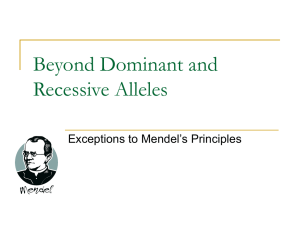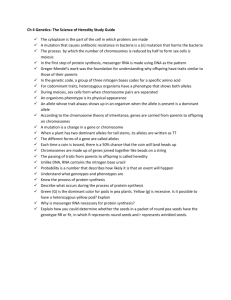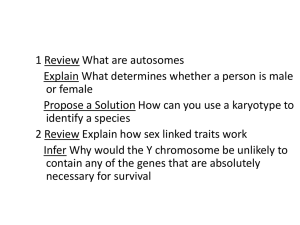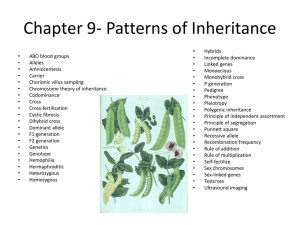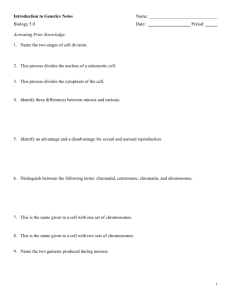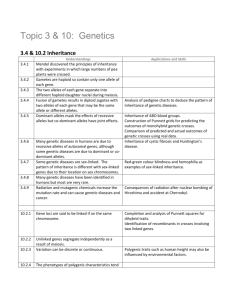Chapter 9 – Patterns of Inheritance 9.1 The science of genetics has
advertisement
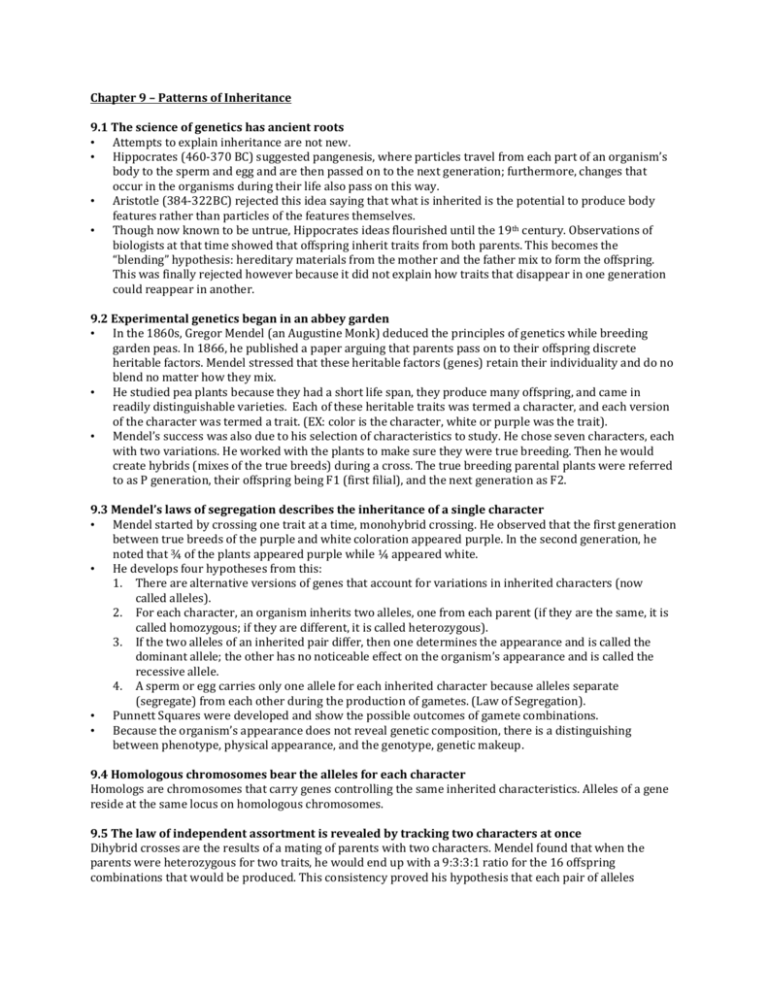
Chapter 9 – Patterns of Inheritance 9.1 The science of genetics has ancient roots • Attempts to explain inheritance are not new. • Hippocrates (460-370 BC) suggested pangenesis, where particles travel from each part of an organism’s body to the sperm and egg and are then passed on to the next generation; furthermore, changes that occur in the organisms during their life also pass on this way. • Aristotle (384-322BC) rejected this idea saying that what is inherited is the potential to produce body features rather than particles of the features themselves. • Though now known to be untrue, Hippocrates ideas flourished until the 19 th century. Observations of biologists at that time showed that offspring inherit traits from both parents. This becomes the “blending” hypothesis: hereditary materials from the mother and the father mix to form the offspring. This was finally rejected however because it did not explain how traits that disappear in one generation could reappear in another. 9.2 Experimental genetics began in an abbey garden • In the 1860s, Gregor Mendel (an Augustine Monk) deduced the principles of genetics while breeding garden peas. In 1866, he published a paper arguing that parents pass on to their offspring discrete heritable factors. Mendel stressed that these heritable factors (genes) retain their individuality and do no blend no matter how they mix. • He studied pea plants because they had a short life span, they produce many offspring, and came in readily distinguishable varieties. Each of these heritable traits was termed a character, and each version of the character was termed a trait. (EX: color is the character, white or purple was the trait). • Mendel’s success was also due to his selection of characteristics to study. He chose seven characters, each with two variations. He worked with the plants to make sure they were true breeding. Then he would create hybrids (mixes of the true breeds) during a cross. The true breeding parental plants were referred to as P generation, their offspring being F1 (first filial), and the next generation as F2. 9.3 Mendel’s laws of segregation describes the inheritance of a single character • Mendel started by crossing one trait at a time, monohybrid crossing. He observed that the first generation between true breeds of the purple and white coloration appeared purple. In the second generation, he noted that ¾ of the plants appeared purple while ¼ appeared white. • He develops four hypotheses from this: 1. There are alternative versions of genes that account for variations in inherited characters (now called alleles). 2. For each character, an organism inherits two alleles, one from each parent (if they are the same, it is called homozygous; if they are different, it is called heterozygous). 3. If the two alleles of an inherited pair differ, then one determines the appearance and is called the dominant allele; the other has no noticeable effect on the organism’s appearance and is called the recessive allele. 4. A sperm or egg carries only one allele for each inherited character because alleles separate (segregate) from each other during the production of gametes. (Law of Segregation). • Punnett Squares were developed and show the possible outcomes of gamete combinations. • Because the organism’s appearance does not reveal genetic composition, there is a distinguishing between phenotype, physical appearance, and the genotype, genetic makeup. 9.4 Homologous chromosomes bear the alleles for each character Homologs are chromosomes that carry genes controlling the same inherited characteristics. Alleles of a gene reside at the same locus on homologous chromosomes. 9.5 The law of independent assortment is revealed by tracking two characters at once Dihybrid crosses are the results of a mating of parents with two characters. Mendel found that when the parents were heterozygous for two traits, he would end up with a 9:3:3:1 ratio for the 16 offspring combinations that would be produced. This consistency proved his hypothesis that each pair of alleles segregates independently of other pairs during gamete formation. This is called Mendel’s Law of Independent Assortment. 9.6 Geneticists use the testcross to determine unknown genotypes When you are unable to determine the genotype by simply looking at the animal, a testcross should be performed. In a testcross, a homozygous recessive individual is crossed with the unknown individual. The resulting offspring should give a clue to the genotype of the unknown. 9.7 Mendel’s laws reflect the rule of probability Mendel’s background in mathematics helped him understand the statistical nature of inheritance. A few things we need to understand: 1. The outcome of a particular event is unaffected by what happened in previous events (independent event). 2. The rule of multiplication of events holds that if two events happen simultaneously, the outcome of each event is an independent event and this compound event is the product of the probabilities for each of the independent events. 3. The rule of addition – the probability that an event can occur in two or more alternate ways is the sum of separate probabilities. 9.8 Genetic traits in human can be tracked through family pedigrees Since we cannot control human matings, then how can the inheritance patterns be determined in human populations? Geneticists collect information from the family in question and construct a pedigree. The pedigree is a family tree constructed from this information. To analyze the pedigree, the geneticist applies logic and Mendel’s laws. These laws can help us deduce genotypes for most of the people in the pedigree. 9.9 Many inherited disorders in humans are controlled by a single gene • Most human disorders are recessive and range in severity. Most people who have recessive disorders usually have normal parents who both passed on a recessive trait. With increased mobility, the likelihood of a recessive trait passing on becomes less likely. Unless there is a close relation of the parents • A number of human disorders are caused by dominant alleles. Some of these are harmless traits (polydactyly), while others can be quite serious (achondroplasia or Huntington’s). Dominant alleles causing diseases are less common than recessive. A dominant lethal allele cannot be carried on the heterozygote without causing an effect. Many lethal dominant alleles result from mutations in the sex cells that subsequently kill the embryo. 9.10 New technologies can provide insight into one’s genetic legacy Genetic Testing The genetic risk for many diseases is determined by whether or not the parents are carriers of the disorder. Some may benefit from testing for dominant alleles in a process called genetic screening. This gives parents the option to decide if it would be safe for them to have a child. Fetal Testing :Several technologies exist to detect genetic conditions in a fetus • Amniocentesis extracts fluid from the womb and allows the doctor to construct a karyotype • Chorionic villus sampling (CVS) the doctor extracts a sample of the chorionic villi from the placenta and the chromosomes are karyotyped Fetal Imaging: Ultrasound imaging uses sound waves to produce a picture of the fetus. Fetoscopy inserts a fiber optic viewing scope into the uterus to obtain pictures. Newborn Screening: Some genetic disorders are detectable at birth by routine testing. Ethical Considerations: As new technologies arise, scientists are trying to make sure that they do not cause more problems than they solve. If genetic testing is done on the parents, and an issue is found, will this effect them in other aspects such as their ability to get health insurance? If the fetus has a disorder, the parents then have the decision to terminate the pregnancy or deliver a baby with the disorder. 9.11 Incomplete dominance results in intermediate phenotypes • Mendel’s laws explain inheritance in terms of discrete factors passed along from generation to generation according to rules of probability. However, his laws do not explain all aspects of inheritance. It cannot explain complicated inheritance patterns or rare patterns. • Complete dominance – the dominant allele had the same phenotypic effect whether it was present in one or two copies. • Incomplete dominance – in some characters, the phenotype falls between the phenotypes of the two parental varieties. 9.12 Many genes have more than two alleles in the population • Most genes can be found in more than two versions, called multiple alleles. For example, the ABO blood group involves three alleles of a single gene. This typing refers to the presence of a carbohydrate on the red blood cells: carbohydrate A (type A), carbohydrate B (type B), both carbohydrates (AB), or none (Type O). • The four blood groups develop from combinations of the three different alleles. Each person gets one allele from each parent. A and B are considered codominant because they express equally, as seen in type AB blood. 9.13 A single gene may affect many phenotypic characters Pleiotropy is a case where one gene influences many characteristics. An example in humans is Sickle Cell • Homozygotes suffer from the disease • Heterozygotes are usually healthy but may suffer some symptoms, especially in higher altitudes when oxygen may be reduced. 9.15 The environment affects many characters Many characteristics result from a combination of heredity and environment. Although an individual is locked in by its genotype, its phenotype can be influenced by the environment in which it lives. Individual features of any organism arise from a combination of genetic and environmental factors, but only genetic influences are inherited. 9.16 Chromosome behavior accounts for Mendel’s laws Chromosome Theory of Inheritance – genes occupy specific loci on chromosomes and it is the chromosomes that undergo segregation and independent assortment during meiosis. The behavior of chromosomes during meiosis and fertilization accounts for inheritance patterns. 9.17 Genes on the same chromosome tend to be inherited together In 1908, William Bateson and Reginald Punnett observed inheritance patterns that were inconsistent with Mendelian laws. They discovered linked genes that do not follow the laws of independent assortment. Genes located close together on the same chromosome tend to be inherited together and are considered linked. 9.18 Crossing over produces new combinations of alleles Crossing over between homologs produces new combinations of alleles in gametes. Genes that have been altered by crossing over are considered recombinant, because they contain new combinations of traits. 9.19 Geneticists use crossover data to map genes The idea that the greater the distance between two genes, the more points there are between them and where crossing over could occur. With this in mind, the concept came to assign relative positions to the genes on the chromosomes and therefore map the genes. 9.20 Chromosomes determine sex in many species Many animals have a pair of sex chromosomes, designated X and Y, that determine gender. In humans, XX is females and XY is male. Human males and females have 22 pairs of autosomes (body chromosomes) and one pair of sex chromosomes. During meiosis, each gamete will receive half of these pairs. In females, all eggs will receive an X, while in males, the sperm could receive either an X or a Y. Gender is determined by which sperm fertilizes the egg first. In 1990, the SRY gene was found on the Y chromosome. It is responsible for triggering the development of the testes. In the absence of SRY, the ovaries develop. In other systems, the XY code is not used. In some insects, the XO system is used, where the female has one additional chromosome over the male. The female would be XX, but the male would be XO, where a second chromosome is not present. In some fish, birds, and butterflies, the egg determines the gender of the offspring. These systems are termed with Z, where ZZ is male and ZW is female. Some organisms lack sex chromosomes all together. Chromosome number determines gender. In bees, females develop from fertilized eggs and are diploid, while males develop from unfertilized eggs and are haploid. 9.21 Sex-linked genes exhibit a unique pattern of inheritance A gene located on either sex chromosome is called a sex-linked gene, although it has often been used to refer to genes on the X chromosome. 9.22 Human sex-linked disorders affect mostly males A number of human conditions result from X-linked recessive alleles. If a male inherits only one sex-linked recessive allele from his mother the allele will be expressed. However, a female has to inherit two of the alleles in order to exhibit the trait. 9.23 The Y chromosome provides clues about human male evolution The human Y chromosome passes essentially intact from father to son. The discovery of sex chromosomes and their pattern of inheritance was a breakthrough of how the genes are passed from generation to generation.


